W A Hindley:
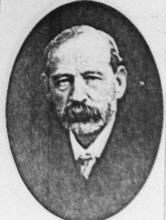 At the 1928 Annual Meeting, there were expressions of dissent at the departure from the strict order of the prayer book service and the Rectors Warden, H M Prince, resigned from office, as did the P C C secretary W A Hindley.
At the 1928 Annual Meeting, there were expressions of dissent at the departure from the strict order of the prayer book service and the Rectors Warden, H M Prince, resigned from office, as did the P C C secretary W A Hindley. Mr Whatmough had a long and eventful - if not totally successful - incumbency. This was his first Parish as Rector.
Mr Whatmough had a long and eventful - if not totally successful - incumbency. This was his first Parish as Rector.
Mr Whatmough made a number of changes in the Parish, including:
Introduction of a mid-week service of Compline.
Taking an East facing position for The Creed
The first use of an Altar (instead of the previous open table)- this first altar was in the Lady Chapel in 1979.
Adding to the altar a cross and candlesticks.
Introduction of new ceremonial- for example on Mothering Sunday, the ladies processed wearing veils.
1926 was a troubled year, the year of the General Strike.
W A Hindley:
 At the 1928 Annual Meeting, there were expressions of dissent at the departure from the strict order of the prayer book service and the Rectors Warden, H M Prince, resigned from office, as did the P C C secretary W A Hindley.
At the 1928 Annual Meeting, there were expressions of dissent at the departure from the strict order of the prayer book service and the Rectors Warden, H M Prince, resigned from office, as did the P C C secretary W A Hindley.
In 1928, the Revised Prayer Book, passed by the Church of England, was rejected by Parliament. Today, Parliamentary approval is no longer required, and most of the 1928 revisions have resurfaced in the form of the Series One Alternative Services.
In 1929 Alderman James Fearnley died, leaving the Parish five hundred pounds for the maintenance and repair of the fabric of the Church. This legacy was subsequently registered with the Charity Commissioner and still in 1979 continued to provide a small income.
In 1930 a form of Free Will Offering scheme was introduced and a special Treasurer was appointed at a salary of ten shillings (50p) per week - around five pounds by 1979 prices. In view of the extra expenditure, the paid choir was dispensed with and a voluntary choir inaugurated. The Organist Mr H S Greenwood retired in 1931. Under regulations in force in 1979, the Treasurer had to be a member of the PCC and receive no reward.
In 1931, the pew rents, which in earlier years were the sole income the church received, ceased to be shared between the rector and the parish, and were paid in full to Mr Whatmough.
In this year the church held services at 8am (Holy Communion), 10:30 Mattins, and 6.30 Evensong. Twice a month following Mattins there was a further celebration of Holy Coimmunion. The church was kept open during the day for private prayer.
The country continued to be troubled and 1932 saw the Hunger Marches, with unemployment at almost three million, against a smaller population than today.
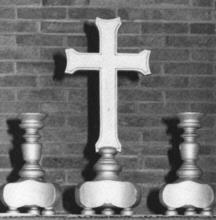
He also proposed curtaining the altar on three sides , supported by four dark oak riddle posts. Up to the 1970's two of these posts could be seen in the Lady Chapel to support a dorsal curtain behind the altar, but were in storage in 1979. The 1933 cross and candlesticks were in the Lady Chapel in 1979.
The PCC agreed to the proposed changes and the usual form of petition (required by Church law) was affixed to the Church door, asking dissenters to make their views known to the diocese. There was a subsequent query whether the notice had been exhibited for the required period.
An objection was lodged with the diocese signed by 25 people, which included:
R Billing - a member of the PCC from 1923-1928
H M Prince - the Rectors Warden from 1920 to 1928
W A Hindley - P C C Secretary from 1920-1928
C Davidson - P C C Member in 1933.
In response to this objection, Mr Whatmough sent a very lengthy (six pages of foolscap paper) reply to the Diocese, denigrating the signatories somewhat personally, claiming that they were the cats-paws of a ring leader whose only interest was to harm the parish. The Diocese was not informed of the above named gentlemens previous participation in Parish affairs.
The Diocesan Registrar initially demanded that the objection be withdrawn, and then recommended to the Chancellor that it be ignored. The Faculty required by Church law was granted.
Somehow this matter fails to illustrate very much Christian love in the Parish at the time.
Technically a Faculty is required for any changes to the furnishing of a Church - somewhat akin to Planning Consent. Several somewhat similar changes made in the 1970's were not only without a Faculty but also without prior PCC consent. In the later case those who were unable to adjust to the changes resigned and left, with regrets, which seems slightly more civilised.
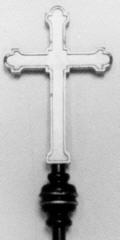 At some time whilst Mr Whatmough was Rector, a Bishops Chair was purchased from a local antique shop and placed in the sanctuary. Does anyone know what the carvings represent?
At some time whilst Mr Whatmough was Rector, a Bishops Chair was purchased from a local antique shop and placed in the sanctuary. Does anyone know what the carvings represent?
A further introduction by Mr Whatmough was a wooden processional cross which we still have. To make processing easier, the font was removed from the front of the church to the back of the church, near to the present Lady Chapel.
The Church records indicate that from 1934 a number of organs were bought, given or lent, and we can assume that the Jardine organ of 1897 was no longer in a satisfactory state. We have no further details of these alternative organs, which must have been at least semi-portable.
In 1935 the Rectory received a telephone.
This was a hectic period in Stockport's history, with an enormous amount of building work going on - Stockport School Mile End Lane which opened 27th August 1938, the covering of an extra part of Mersey Square, sometimes referred to as the Bear Pit - originally planned as a car park with attendant! - followed by the covering of the River Mersey from Mersey Square to Lancashire Hill - the start of aircraft manufacture on Crossley Road (Fairey Aviation) - the extension of the Town Hall left into Ebeneser Chapel (now demolished) - and the opening of Bramall Hall. And then...
The Liverpool architect Mr B A Miller, who had done work on other Cheshire churches, was called in. Mr Miller designed a new church to run parallel to Buckingham Road (not Wellington Road). His sketches appeared in the Guardian of 22nd October 1935, which can be consulted in Manchester Central Library.
The design was for a concrete structure, reminiscent of a luxury liner in appearance.
The plans were alas rejected by both the Diocese and the Church Commissioners, who were not too happy with the design, and also felt that the parish was not in a position to finance such grandiose work. The cost would have been in excess of twelve thousand pounds.
Two further plans were drawn up, and the contract was awarded to Wm Thorpe for GBP 4,712. Additional work increased the cost (as seems normal with such schemes).
In view of the Parish's financial position, only the Chancel was to be rebuilt at first. (Was there any honest realistic intent to do more?). This part of the building, although built after the main Nave, had been built at different times and was in the worst condition, suffering from rot and a lack of adequate foundations.
The new Chancel was to have a squarish shape to allow the remainder of the church to be later rebuilt parallel to Buckingham Road. The old East Window was stored in the gallery, with the other glass in the transepts disappearing.
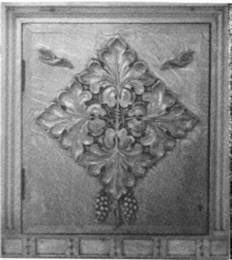
The Bishop of Manchester laid the foundation stone on17th December 1935, and the new Chancel was consecrated by the Bishop of Manchester on 20th November 1937.
The Aumbrey (which is in the North wall of the Chancel) seems to have been inserted in 1939. The carved oak door which cost six pounds was designed by Mr Miller. An aumbrey is a cupboard, and in a church is a recessed store in which the reserved sacrament is stored.
The Altar - originally introduced by Mr Whatmough- was now replaced by a larger altar. The old altar was moved into the Lady Chapel, which at this time was located in the corner by the new vestry, in 1979 this area was referred to as the childrens corner but was not used as such.
A new blue frontal and dorsal curtain were purchased for GBP 41, worked by the Church Embroidery Society of St Nicholas.
Two floor standing wooden candlesticks, painted silver, were reported to be the personal gift of Mr Miller.
The final cost of the work was GBP 5,759. The builder seems to have experienced problems in obtaining payment and the debt continued for many years.
The new choir stalls, pulpit and reading desk, in light oak, were by Shepherdsons of Stockport (removed after the 1980's to open up the chancel and enable the communion table to be brought well forward).
The St Christopher emblem over the childrens corner was originally intended for the church of St Christopher at Withington, on which Mr Miller was also working, but was surplus to trheir requirements. Mr Miller therefore offered it to St Thomas. Mr Miller subsequently became architect to Chester Cathedral, from 1945 to his death in 1960.
Despite a specific warning from the Diocesan Registrar, Mr Whatmough gave instructions for the Chancel foundations to be dug before the legal requirements had been met. The bodies of some parishioners were disturbed during the work (parts of the chancel having been built over the graveyard) and were re-interred elsewhere. Disturbing graves without legal consent is not merely a Church offence, but no action was taken against Mr Whatmough.
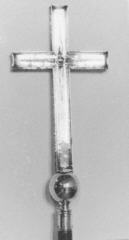
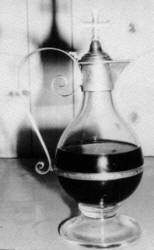 The problems in the parish were perhaps minor compared to the war which was going on, but there seems to be little record of the war in church records. The country at large was also seeing an increasing number of divorces- the figures seem astonishingly small today- 801 in 1913, 3747 in 1920, but 8396 in 1940.
The problems in the parish were perhaps minor compared to the war which was going on, but there seems to be little record of the war in church records. The country at large was also seeing an increasing number of divorces- the figures seem astonishingly small today- 801 in 1913, 3747 in 1920, but 8396 in 1940.
The last burial recorded in the church yard was in 1943
In 1942 a prayer book was presented by Mr and Mrs J C Langhorn "for recovery to health" and later a flagon was presented in memory of R K Ridgway, killed in action in 1944. The silver processional cross was dedicated in memory of Walter Chapman (it was designed by messrs Taylor and Young and made by J T Birchall of Cheadle). Mr Langhorn was the Verger and lived in the schoolmasters house near to the Church.
About the time the new building work was taking place, tragedy struck Mr Whatmough when his wife was killed in a motoring accident. In her memory, the Mothers Union, of which she was Enrolling Member, gave a Sanctuary Lamp (removed around 1992).
Given the disturbance in the Parish, as the church was moved rapidly from very low church to pretty high church, it is not surprising to find conflicting reports of the domestic problems.
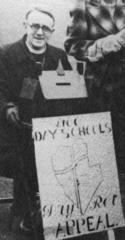 Mr Whatmough in 1942
Mr Whatmough in 1942
As an example, one supporter reported that Mr Whatmough did not wear vestments, burn incense, genuflect or cross himself, but that there was a group pressuring him to increase the use of ceremonial - and that a member of this group burned incense without his consent.
Mr Whatmough left the parish for Cuddington.
One of the members of the congregation at this time was a young man who did favour the use of ceremonial, one George K Giggall, who lived not far from the church on Wellington Road. His father ran a butcher's shop on Heaton Moor Road, which later became Mathew's Butchers. Read The memories of Kenneth Giggall
Another local parishioner at this time was Rupert Gurney, born in 1917., the son of Rupert Gurney (Mayor of Stockport in 1944). Gurney's Paper Shop on the A6 was for many years a focus of the local community, but a ban on parking outside and the closure of most of the other shops greatly reduced the number of people passing by who would have called in. Rupert died in 2014 but we have available here The memories of Rupert Gurney of this period.
 Evening communion on the fourth Sunday of the Month was established by Mr Noble. An amplifier was purchased together with a microphone and a recording of a peal of bells. A loudspeaker was placed in the bell turret and the old bell fell into disuse.
Evening communion on the fourth Sunday of the Month was established by Mr Noble. An amplifier was purchased together with a microphone and a recording of a peal of bells. A loudspeaker was placed in the bell turret and the old bell fell into disuse. A prayer book was given in Memory of G Crimes.
The question of a new organ arose. The firm of Harrisons inspected the Jardine organ, and pronounced the parts useless. The small local firm of Walkletts decided the old parts could be reused, and as their quotation was half that of Harrisons, the Church looked no further and awarded the contract to them, although there were those in the Parish who felt that this was a little short-sighted.
The proposed three manual organ would be the most ambitious attempted by this firm, with an estimated cost of GBP 2995.
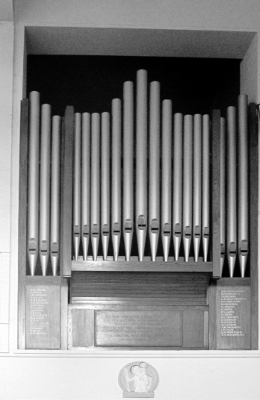 In 1949 the Secretary reported on the negligence and discourtesy of Walkletts in not replying to two letters sent to them.
In 1949 the Secretary reported on the negligence and discourtesy of Walkletts in not replying to two letters sent to them.
Nevertheless, finally the organ was installed and was dedicated by the Bishop of Manchester on October 3rd 1951, as a memorial to those who had died in the Second World War. The organ panel over the old Lady Chapel was by Shepherdsons (in 1979 this area became known as the Childrens Corner).
The list of those lost in the War is nearly alphabetical and lists (in the order given):
W H Abram, J Abram, F R Arthan, H Bagley, W H R Bailey, N W Bromley, A Bowker, W Cowan, G Crimes, K Clews, C W Elliott, D M Emery, R Eves, J A Goodger, H Gregory, L Harrop. K Hall, K Harrison, N K Hodgkinson, R Humphreys, S F Kilbery, C H MOttershead, F P Newcombe, R K Ridgway, G J Royle, C Smith, R S Smith, N Shaw, K C Simpson, E M Skelley, J W Taylor, N V Taylor, A R Thomson, F H Wade, D W Whittaker, T N Woodhead.
Sadly, a more modern listing appeared on the wall under the organ case with slightly differing names: differing surnames include: Grimes for Crimes. The name on the organ panel is correctly Crimes, who served in the RNVR. Barley for Bailey- W Bailey as shown on the organ panel is correct, he served in the Merchant Navy. Elliott is as on the panel with two Ts. The names are referenced also on the Heaton Moor War Memorial. The framed names list with the errors was removed in 2020 when the PCC became aware of the problem content.
So poor was this new organ that the final sixty pound payment was never made, and the organ problem continued.
In 1949 the Electoral Roll was 226, compared to its starting figure in 1920 of 221.
In 1951 a Litany Stall was presented in memory of Dr A MacGill.
Mr Noble was a very popular incumbent, and the congregation increased greatly under his leadership. He was very conscious of the roll which social activities could play in the Church. A very low church man, not everyone responded to him coming after Mr Whatmough.
We are told that he celebrated Communion from the side of the Table - a position which was intended to remove any thought that the minister had a priestly or mediatorial role in the proceedings. He also removed the Aumbrey door, using the recess simply as a store for the alms plate.
In 1947 there had been little change to the services- Holy Communion following Mattins on the first Sunday of each month had now become a Choral Communion with sermon. The morning services had become a little later and were at 10:45.
Writing in the Parish Magazine in November 1947, Mr Noble wrote:
... it is no use our blaming any form of Government for a state of affairs for which we are all, in greater or lesser degree, responsible. The one sure road of deliverance from our present national plight is the road back to God. More prayer, communion, worship and service must mark every one of our lives.
On 5th October 1947, there were 72 communicants recorded in the service book.
Stanley Graham recalls that the tram lines outside the church had been relaid with labour from Italian prisoners of war (probably after the end of the war, maybe circa 1945).
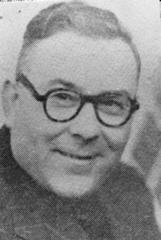 Mr Davies came to St Thomas from Christ Church, Bacup.
Mr Davies came to St Thomas from Christ Church, Bacup.During the war he had served as an army chaplain and his duties at Anzio (Italy) featured in a pictorial magazine spread.
The story of the organ continued... in 1953 Walkletts went into liquidation, following the retirement due to ill health, of Mr Walklett.
In 1954 an inspection was made of the organ by someone from the College of Music, and two firms of organ builders. We read in the minutes of the PCC: the Church organ has been pronounced by three experts as hopeless... use of inferior materials... the firm that built the organ is now no more and thus we have no redress.
The church was in no position to have yet another new organ installed, and repairs were limited to a new blower and 170 new pipes. Already the third manual ceased to function. The cost of this incomplete remedial work was GBP 800.
In 1955 the Diocesan magazine reported- Arising out of certain unfortunate experiences suffered by one or two parishes which have been faced with the task of organ building and repair, the Board of Finance has consulted... with the Diocesan Advisory Committee for the Care of Churches. That Committee wishes it to be known that it possesses an advisory service in this field.
The organ continued to limp on, with less and less of it functioning and only the skill of the organists kept the music going. Replacement of the organ was an ongoing topic for discussion- by 1979 the quoted cost of a small pipe organ was GBP 7,000.
In 1953 Gift Day was in December- near to the Saint Day of St Thomas, but in 1955 Gift Day was moved to July- the month in which the Church had been consecrated.
In 1954 the Electoral Roll stood at 283, but the average number of communicants was a mere 30.
In 1956 the Altar rail gates were fitted, donated by Dowson and Mason of Levenshulme, with the hinges donated by Pianoforte Supplies Ltd of Northampton (removed after 1990 to allow for the chancel to be opened up and the communion table moved well forward). Kneeling desks and a chair, made by Shepherdsons, were purchased for the sanctuary.
The old rectory being too large and in poor condition, a resolution was passed to build a new rectory. The position of the school was also discussed: in order to retain its status as an Infants AND Primary school, an extension was required, and a larger playground was needed. The only land available for the extra playground was the churchyard.
By 1957 the Electoral Roll stood at 432. The foundation stone of the new rectory was laid - it was to be built in the front garden of the old rectory and was completed in the same year, being dedicated on 4th December.
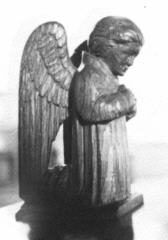 The old font was cleaned and restored by Mr Gutteridge, and a new font cover made in light oak by Shepherdsons, with two carved angels, was given by Mr and Mrs Gutteridge in memory of "M R Gutteridge 1947-1956". The new cover was dedicated on 23rd June.
The old font was cleaned and restored by Mr Gutteridge, and a new font cover made in light oak by Shepherdsons, with two carved angels, was given by Mr and Mrs Gutteridge in memory of "M R Gutteridge 1947-1956". The new cover was dedicated on 23rd June.
In 1958 Mr Handford, organist for 21 years, resigned - he died in 1979. The old rectory was still standing- in case it had to be used as a temporary home for the school during rebuilding - however the high cost of the alterations required to the old rectory before the Council would approve its use as a temporary school ensured that this idea was not proceeded with.
The West End of the Church was now in poor condition, suffering from rot, and it was proposed to build a new entrance, "the Narthex". It was also proposed to add at this time a wardens vestry and also a new choir vestry, with the possibility of a meeting room.
Miss Briscoe died and left the church a large bequest, which was invested and by 1979 provided a useful income.
The amplifier, which had been restored in 1953, was by 1958 in need of further work, and it was decided that the church bell should be used for a trial period before any repair was carried out to the amplifier. The trial seems to have succeeded as the bell continued to toll until the rope fell off in the mid seventies at which point the safety of the basic structure was called into question.
In 1959 a sanctuary chair was installed, given by Mr and Mrs Burdett in memory of D F Burdett.
By 1959 the Electoral Roll showed a small increase to 443.
The closure of the churchyard was approved - there had been a few objections, and it is pleasing to note that the objectors were received with sympathy and tact. It was ruled that four of the gravestones should be given new positions, on display, and left there (for W Wigglesworth, R Lawson, E E Bleasby, and a fourth unknown to me).
The church decided to use the other gravestones as paving and to place around the boundary. The churchyard boundary with the school was marked with a kerb, which was then buried beneath the tarmac. No bodies were disturbed. A condition of the agreement was that should the school close, the Council would remove the tarmac and lay turf to provide a garden of rest.
Sadly many years later, in 2015, a number of deep holes were drilled through the tarmac and any remains underneath in order to provide a fenced area in the already fenced playground.
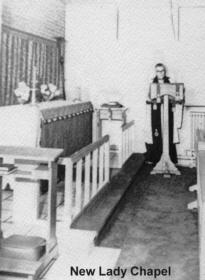
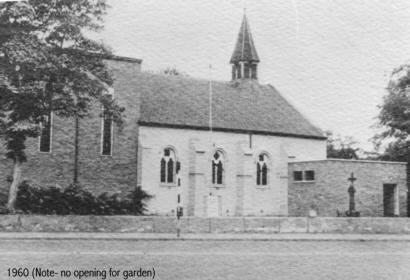 The plans for the new West End were revised, with the proposed new choir vestry now becoming a new Lady Chapel, whilst the possibility of a two story structure for a meeting room was dropped. Lack of funds prevented any action being taken with regard to the heating system or the organ.
The plans for the new West End were revised, with the proposed new choir vestry now becoming a new Lady Chapel, whilst the possibility of a two story structure for a meeting room was dropped. Lack of funds prevented any action being taken with regard to the heating system or the organ.
In 1960 the rebuilding of the West End was undertaken. This was done by Wm Thorpes, who had built the West End. The original estimate was GBP 5,725. Great care was taken to match the bricks with those used for the East End, the the possibility of facing the old Nave with the same bricks was looked into but dropped due to cost.
Due to the extent of the rot, the actual work required was greater than originally thought, and the final cost was around seven thousand pounds. A second hand replacement boiler was purchased for GBP 175, and Mr Clem Rutter made the wooden candle holders since used regularly at the annual Carol Service.
In 1961 Mr Edward Paine was appointed organist. We have seen a report made in this year that the old East Window was still stored away. Enquiries seem to indicate that it was at this time in the old Rectory.
By 1962 the new West End was completed and was dedicated on 28th October. Amongst the new furniture provided were a light oak lectern and bible (in memory of C J Knight), gilded limewood cross and candlesticks (in memory of Miss G M Briscoe), and an altar table (in memory of J Bowker). This was an altar table, not an altar, and in 1979 could be seen on the right side of the Sanctuary, in front of a small recess in the wall.
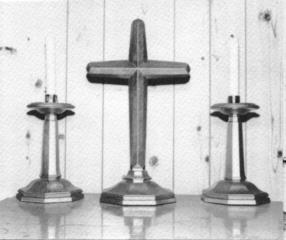 A national shortage of funds meant that no progress was made with the school extension. Negotiations commenced with the Council for the area in front of the church, alongside Wellington Road North, to be laid out as a public garden, an "open space".
A national shortage of funds meant that no progress was made with the school extension. Negotiations commenced with the Council for the area in front of the church, alongside Wellington Road North, to be laid out as a public garden, an "open space".
In 1964 the old rectory was finally demolished. Unfortunately Mr Davies permitted the first contractor to remove the valuable materials (including possibly the East Window) after which the contractor was not to be seen again. It was cheaper to pay for a new contractor to finish the work than to take legal action. Part of the rectory grounds were then sold and the proceeds applied to reduce the mortgage on the new rectory (which had oil fired central heating).
There was a gradual decline in the number of communicants over this period- 115 in 1960, 100 in 1963, 90 in 1964, and 60 in 1965.
Mr Davies left the parish and became vicar at St Paul, Sale, Cheshire until 1975. He died in 1979 after becoming a rural dean and an Hon. Canon of Chester Cathedral.
St Thomas then had a lengthy interregnum.
Church History: Page One || Page Two (1844-1879) || Page Three (1880-1926) || Page Five
Access Key Details
Stephen's Entry Page |
TI99/4a |Linux |Search |
History St Thomas Church Heaton Chapel |
Entertainment | Music Links
Light Reference | Educational Reference | Science Fiction |
Travel | News Links | Anime